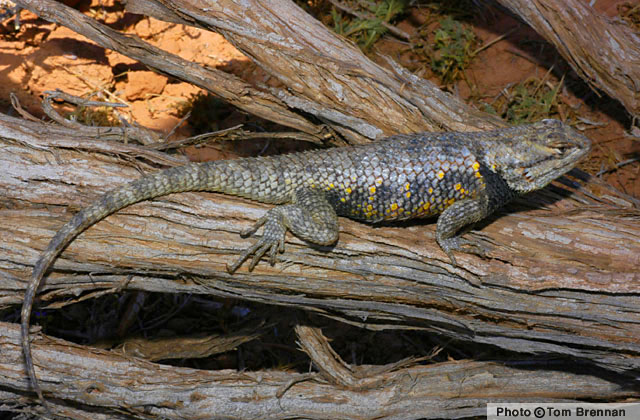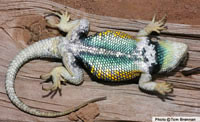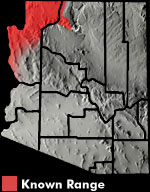Online Field Guide to The Reptiles and Amphibians of Arizona



Male. Mohave County, AZ
 Male Venter, Mohave Co., AZ |
| YELLOW-BACKED SPINY LIZARD Sceloporus uniformis | |
|
DESCRIPTION: A large (up to about 142 mm or 5.6″ from snout to vent), stocky lizard with large, pointed, keeled, overlapping scales. Base coloration is gray, tan, or brown. The back is a uniform yellow or tan grading into darker gray-brown on the sides. Yellow or orange scales are sporadically scattered on the sides of the body. A black wedge shape marks each shoulder. Males have two large, bright, blue-green patches on the belly and a blue-green patch on the throat. Belly and throat patches are faint or absent in females. Its lack of distinct dorsal markings (in adult males) distinguishes this lizard from the similar Desert Spiny Lizard. Its large, black, wedge-shaped shoulder markings distinguish it from many of Arizona’s smaller Sceloporus. Its lack of crossbars on the forelimbs distinguish it from Clark’s Spiny Lizard. DISTRIBUTION: The Yellow-backed Spiny Lizard ranges across northwestern Arizona at elevations ranging from about 150 m (500′) to about 1,500 m (5,000′). HABITAT: The Yellow-backed Spiny Lizard is found in Mohave and Great Basin desertscrub, Great Basin Grassland, Interior Chaparral, and Great Basin Conifer Woodland communities. It is often encountered along riparian corridors, on the lower and more moderate mountain slopes, bajadas, plains, and low valleys. It basks on the branches of trees or on fence posts, wood piles, boulders, rock piles, and packrat nests. BEHAVIOR: This diurnal lizard is often heard before it is seen as it scratches and claws the tree-bark en route to the opposite side of the trunk or branch. It flees down into the inner tangles of pack rat nests, rock crevices, or burrows when threatened. It has strong jaws and often bites when captured. It hibernates during the cold months of winter and late fall. DIET: Prey consists of a variety of insects including ants, beetles, and caterpillars. It also feeds on spiders, centipedes, small lizards, and some plant material. REPRODUCTION: The Yellow-backed Spiny Lizard is often encountered in male-female pairs. Mating takes place in spring and summer and one or two clutches of eggs are laid in spring and summer. Clutch size ranges from 2 to 12 eggs. Hatchlings begin to emerge in late July. By Thomas C. Brennan Brennan, T. C., and A. T. Holycross. 2006. A Field Guide to Amphibians and Reptiles in Arizona. Arizona Game and Fish Department. Phoenix, AZ Brennan, T. C., & A. T. Holycross. 2005. A Field Guide to Amphibians and Reptiles of Maricopa County. Arizona Game and Fish Department. Phoenix, AZ Phelan, R.L., and B.H. Brattstrom. 1955. Geographic Variation in Sceloporus magister. Herpetologica. 11 Schulte, J.A., J.R. Macey, and T.J. Papenfuss. 2006,A genetic perspective on the geographic association of taxa among arid North American lizards of the Sceloporus magister complex (Squamata: Iguanidae: Phrynosomatinae) Molecular Phylogenetics and Evolution 39: 873–880 Stebbins, R.C. 2003. A Field Guide to Western Reptiles and Amphibians, Third Edition. Houghton Mifflin Company, Boston, MA. |
|
Visit Partners in Amphibian and Reptile Conservation:


HOME
Copyright © 2023, Arizona Game and Fish Department. All rights reserved.
If you make use of the textual contents of this site in reports, publications, etc. please cite and credit the author(s) and photographer(s). All photos on this website are copyrighted. However, those found in the species account section may be used for any noncommercial scientific, educational, or conservation purposes provided that photographs are not altered and continue to bear the copyright symbol and name of the photographer. Please contact the photographer regarding commercial use of copyrighted photographs.










